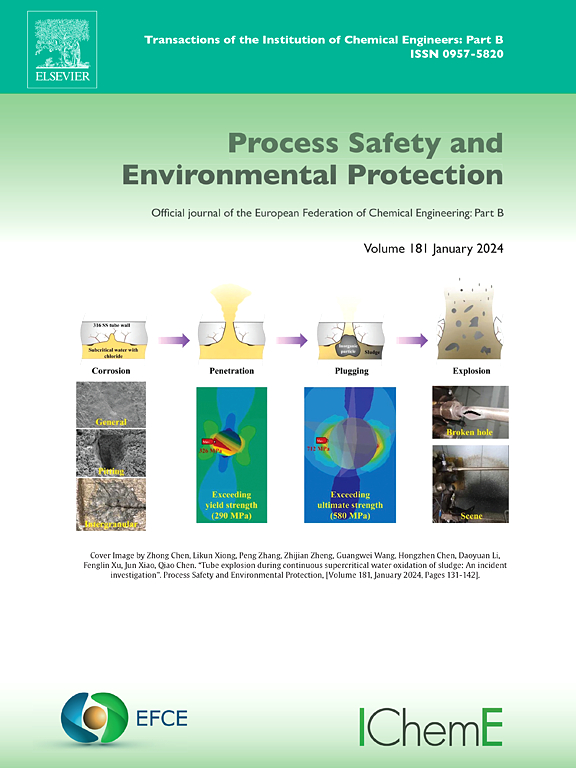不同甲烷混合物下的氢自燃:实验分析和预测模型的建立
IF 6.9
2区 环境科学与生态学
Q1 ENGINEERING, CHEMICAL
引用次数: 0
摘要
研究了甲烷体积分数对氢气自燃的影响。实验在带有圆柱形释放管的自燃平台上进行,重点研究了甲烷体积混合比(0 %、10 %、20 %和30 %)对临界自燃压力(Pcr)、冲击波速度和火焰形态的影响。结果表明,甲烷显著抑制氢自燃。在纯氢条件下,临界自燃压力(Pcr)为4.44 MPa,平均激波速度为1185.5 m/s。当掺加10% %甲烷时,临界自燃压力(Pcr)显著增加至8.63 MPa(约为纯氢气的2倍),而激波速度略有增加至1230.4 m/s。然而,在20% %和30% %的甲烷中,即使在超过17 MPa的压力下也没有观察到自燃现象。结合GRI 3.0、FFCM-1和Aramco 2.0三种常用的反应动力学机制,采用激波点火理论模型。结果表明,理论模型存在较大偏差,不能很好地预测甲烷-氢混合物的自燃行为。结合实验和文献数据,建立了一个GRNN模型,在低甲烷混合比下,准确率达到72.55 %,优于传统模型。该GRNN模型为预测甲烷-氢混合物的自燃标准提供了一种新的方法,为工业过程中的安全排放和储罐设计提供了见解。本文章由计算机程序翻译,如有差异,请以英文原文为准。
Hydrogen autoignition under varying methane blends: Experimental analysis and prediction model development
This study investigates the effects of methane volume fractions on hydrogen autoignition. Experiments are conducted on an autoignition platform with a cylindrical release tube, focusing on the impact of methane volume blending ratios (0 %, 10 %, 20 %, and 30 %) on critical autoignition pressure (Pcr), shock wave velocity, and flame morphology. Results show that methane significantly suppresses hydrogen autoignition. Under pure hydrogen conditions, the critical autoignition pressure (Pcr) is 4.44 MPa, and the average shock wave velocity is 1185.5 m/s. When 10 % methane is blended, the critical autoignition pressure (Pcr) markedly increases to 8.63 MPa (approximately twice that of pure hydrogen), while the shock wave velocity slightly increases to 1230.4 m/s. However, at 20 % and 30 % methane, autoignition is not observed even at pressures over 17 MPa. Theoretical model for shock-induced ignition is employed in combination with three commonly used reaction kinetics mechanisms: GRI 3.0, FFCM-1, and Aramco 2.0. The results indicate that the theoretical model exhibits significant deviations and is not well suited for predicting the autoignition behavior of methane-hydrogen mixtures. A GRNN model is developed by integrating experimental and literature data, achieving 72.55 % accuracy at low methane blending ratios, outperforming conventional models. This GRNN model provides a new approach for predicting autoignition criteria in methane-hydrogen mixtures, offering insights for safe discharge and storage tank design in industrial processes.
求助全文
通过发布文献求助,成功后即可免费获取论文全文。
去求助
来源期刊

Process Safety and Environmental Protection
环境科学-工程:化工
CiteScore
11.40
自引率
15.40%
发文量
929
审稿时长
8.0 months
期刊介绍:
The Process Safety and Environmental Protection (PSEP) journal is a leading international publication that focuses on the publication of high-quality, original research papers in the field of engineering, specifically those related to the safety of industrial processes and environmental protection. The journal encourages submissions that present new developments in safety and environmental aspects, particularly those that show how research findings can be applied in process engineering design and practice.
PSEP is particularly interested in research that brings fresh perspectives to established engineering principles, identifies unsolved problems, or suggests directions for future research. The journal also values contributions that push the boundaries of traditional engineering and welcomes multidisciplinary papers.
PSEP's articles are abstracted and indexed by a range of databases and services, which helps to ensure that the journal's research is accessible and recognized in the academic and professional communities. These databases include ANTE, Chemical Abstracts, Chemical Hazards in Industry, Current Contents, Elsevier Engineering Information database, Pascal Francis, Web of Science, Scopus, Engineering Information Database EnCompass LIT (Elsevier), and INSPEC. This wide coverage facilitates the dissemination of the journal's content to a global audience interested in process safety and environmental engineering.
 求助内容:
求助内容: 应助结果提醒方式:
应助结果提醒方式:


